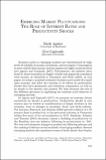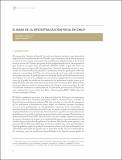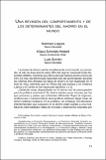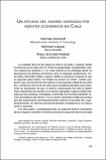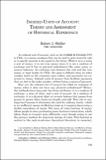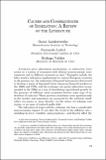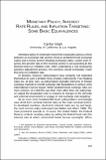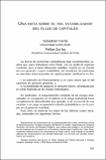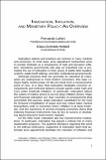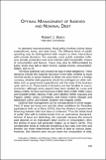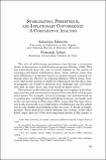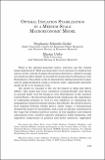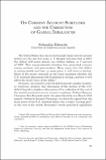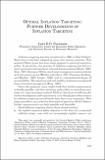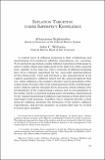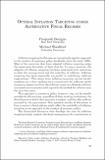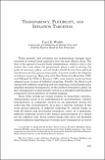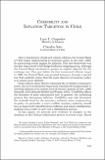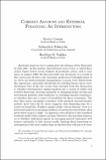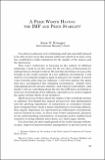Buscar
Mostrando ítems 1341-1360 de 1729
Emerging market fluctuations: the role of interest rates and productivity shocks
Business cycles in emerging markets are characterized by high levels of volatility in income, investment, and net exports. Consumption is more volatile than income, and net exports are highly countercyclical (see Aguiar and Gopinath, 2007). Furthermore, the interest rates faced by these economies are ...
El mapa de la descentralización fiscal en Chile
A partir de una propuesta de Boex y Simatupang (2008) esta investigación estima un indicador de 'empoderamiento fiscal' municipal para Chile (EF) que combina un índice de autonomía fiscal con una medición del grado de control de los residentes sobre el gasto municipal (voice). La principal conclusión ...
Una revisión del comportamiento y de los determinantes del ahorro en el mundo
Las tasas de ahorro varían ampliamente en el mundo: en promedio, el este de Asia ahorra sobre 30% del ingreso nacional bruto disponible (INBD), mientras que África del sub-Sahara ahorra menos de 15%. Es más, las diferencias regionales han ido aumentando: durante las últimas tres décadas las tasas de ...
Un estudio del ahorro agregado por agentes económicos en Chile
La notable alza de las tasas de ahorro privado y público desde comienzos de los años 80 en Chile ha despertado considerable interés. Este interés se ha reflejado tanto en discusiones de política económica como en trabajos académicos. Entre ellos, Morandé (1998) y Agosín (1999) se proponen explicar lo ...
Indexed units of account: theory and assessment of historical experience
An indexed unit of account, such as the Unidad de Fomento (UF) in Chile, is a money analogue that can be used to price items for sale or to specify Amounts to be repaid in the future. While it is in a sense a sort of money, it is not true money since it is not a medium of exchange and it has no physical ...
Causes and consequences of indexation: a review of the literature
Automatic price adjustment mechanisms, or indexation, have arisen in a variety of economies with distinct macroeconomic environments and in different moments in time. Examples include the labor market indexation implemented in various European countries in the postwar era, the indexation of financial ...
Monetary policy, interest rate rules, and inflation targeting: some basic equivalences
Monetary policy in small open economies is typically cast as a choice between an exchange rate anchor (fixed or predetermined exchange rates) and a money anchor (floating exchange rates). Under such regimes, the growth rate of the nominal anchor is set according to the desired long-run inflation rate. ...
Una nota sobre el rol estabilizador del flujo de capitales
La teoría de economías competitivas bajo incertidumbre explica que, para individuos como Chile, con un perfil de ingresos creciente, pero a tasas altamente volátiles, inserto en un mundo de—en general— menor volatilidad, los beneficios de participar en mercados internacionales de capital pueden ...
Indexation, inflation, and monetary policy: an overview
Indexation policies and practices are common in many markets and economies. In most cases, price adjustment mechanisms arise in private contracts as a consequence of high and pervasive inflation. Sometimes governments also play an important role in promoting the use of indexation in their issues of ...
Optimal management of indexed and nominal debt
In standard macroeconomics, fiscal policy involves choices about expenditures, taxes, and debt issue. The different kinds of public spending may be distinguished with respect to their interactions with private decisions. For example, some public activities influence private production and some interact ...
Stabilization, persistence, and inflationary convergence: a comparative analysis
The role of inflationary persistence has become a recurrent theme in discussions on stabilization programs (Fischer, 1986). This has particularly been the case in recent debates on the merits of exchange-rate-based stabilization plans. Some authors claim that anti-inflationary programs based on ...
Optimal inflation stabilization in a medium-scale macroeconomic model
What is the optimal monetary policy, and how can the central bank implement it? Both questions have been extensively studied, but always in the context of simple theoretical structures, which by design are limited in their ability to account for actual observed business cycle fluctuations. This article ...
On current account surpluses and the correction of global imbalances
The United States has run an increasingly large current account deficit over the last few years. J. P. Morgan forecasts that in 2007 the deficit will reach almost one trillion dollars, or 7 percent of GDP. This unprecedented situation has generated concern among analysts and policymakers. Many argue ...
Optimal inflation targeting: further developments of inflation targeting
Inflation targeting was first introduced in 1990, in New Zealand. Since then it has been adopted by more than twenty countries. This period of fifteen years has seen major progress in practical monetary policy. In particular, the practice of inflation targeting has led to a more systematic and consistent ...
Inflation targeting under imperfect knowledge
A central tenet of inflation targeting is that establishing and maintaining well-anchored inflation expectations are essential. Well-anchored expectations enable inflation-targeting central banks to achieve stable output and employment in the short run, while ensuring price stability in the long run. ...
Optimal inflation targeting under alternative fiscal regimes
Inflation targeting has become an increasingly popular approach to the conduct of monetary policy worldwide since the early 1990s. Most of the countries that have adopted inflation targeting judge the experiment favorably, at least thus far. In many countries, the adoption of inflation targeting has ...
Transparency, flexibility, and inflation targeting
Three parallel and certainly not independent changes have occurred in central bank practices over the past fifteen years. The first is the spread of central bank independence, which is tied to the notion that even when the government plays a role in setting the goals of monetary policy, central banks ...
Credibility and inflation targeting in Chile
After a long history of high and volatile inflation, the Central Bank of Chile began implementing its monetary policy in the early 1990s by announcing yearly targets for inflation. This new framework was the first step toward a full-fledged inflation-targeting setup, although the Central Bank continued ...
Current account and external financing: an introduction
Economic analysts were surprised by the collapse of the Thai baht in July 1997. In the months that followed, most of the so-called East Asian Tigers faced severe balance-of-payments crises, and a year later, in August 1998, the Russian ruble was devalued. As a result of this succession of crises, the ...
A prize worth having: the IMF and price stability
It is always a pleasure to be in Santiago and I am especially pleased to be able to join you at this annual conference which in its nine years has established a high reputation for the quality of the papers and the discussion. This year’s conference is focusing on the subject of inflation targeting. ...

